Continuous Implementation Plan for a Newly Acquired Enterprise
VerifiedAdded on 2020/04/01
|13
|3046
|62
Report
AI Summary
This report presents a continuous implementation plan designed to address challenges faced by a newly acquired enterprise experiencing negative customer feedback and declining product quality. It begins with an overview of continuous improvement principles, emphasizing the importance of stakeholder relationships and the application of Kaizen principles. The report then identifies tools such as flow charts and control charts used in the improvement process. The core of the report focuses on methods for solving the firm's problems, including analyzing customer complaints, employee feedback, and performance records. It highlights assumptions such as a lack of cohesion within departments and a missing progress management plan. The report also presents evidence collected, such as poor product quality, lack of post-purchase services, and poor customer service. A detailed continuous improvement plan is proposed, including implementing total quality management, addressing employee issues, and applying Deming’s quality cycle and Six Sigma techniques. The report concludes with recommendations for identifying loopholes, determining root causes, and ensuring that progress is sustained. The report emphasizes the importance of management involvement, infrastructure alignment, training, and the use of statistical tools for continuous improvement. The overall goal is to provide a framework for the company to identify and resolve its issues, improve social cohesion, and sustain long-term business success.
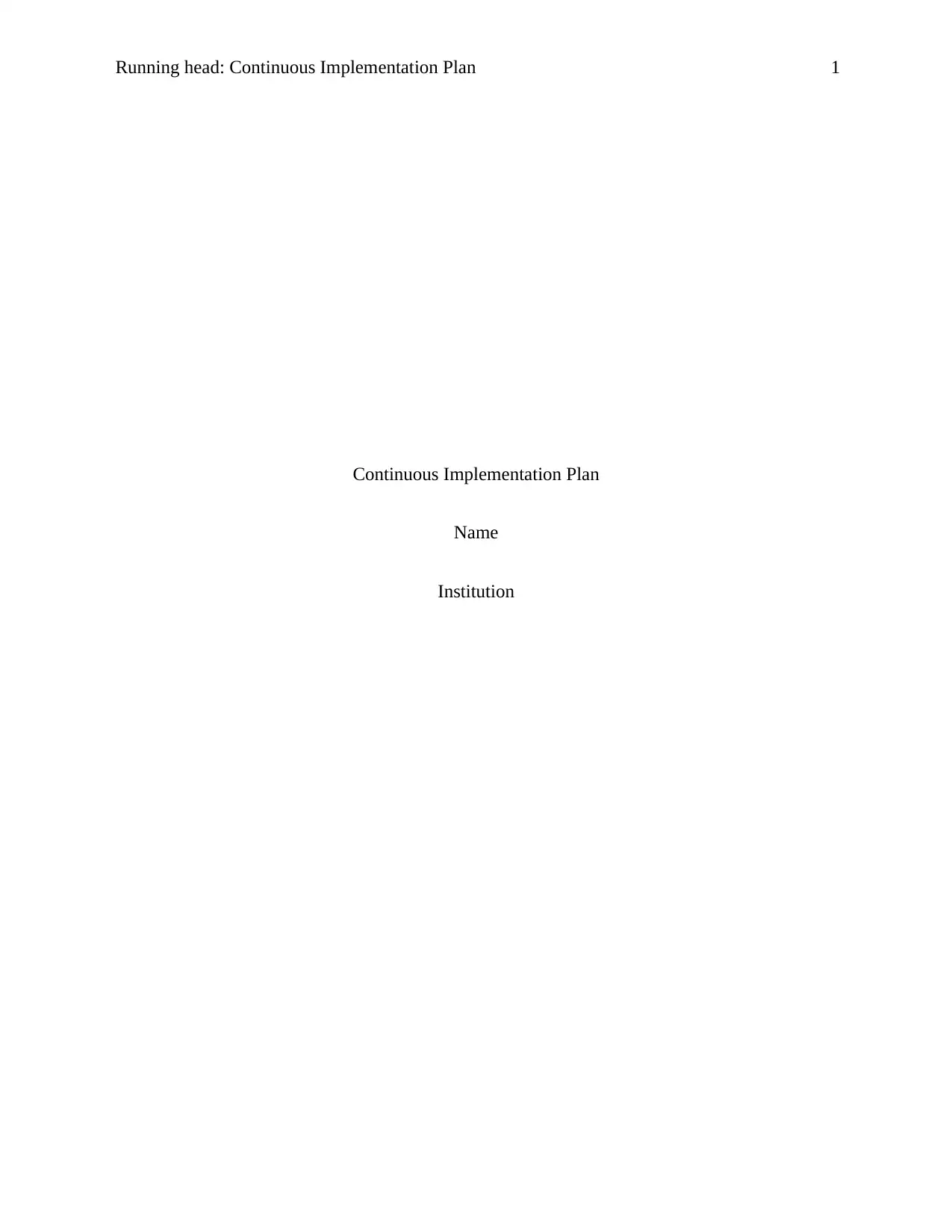
Running head: Continuous Implementation Plan 1
Continuous Implementation Plan
Name
Institution
Continuous Implementation Plan
Name
Institution
Paraphrase This Document
Need a fresh take? Get an instant paraphrase of this document with our AI Paraphraser
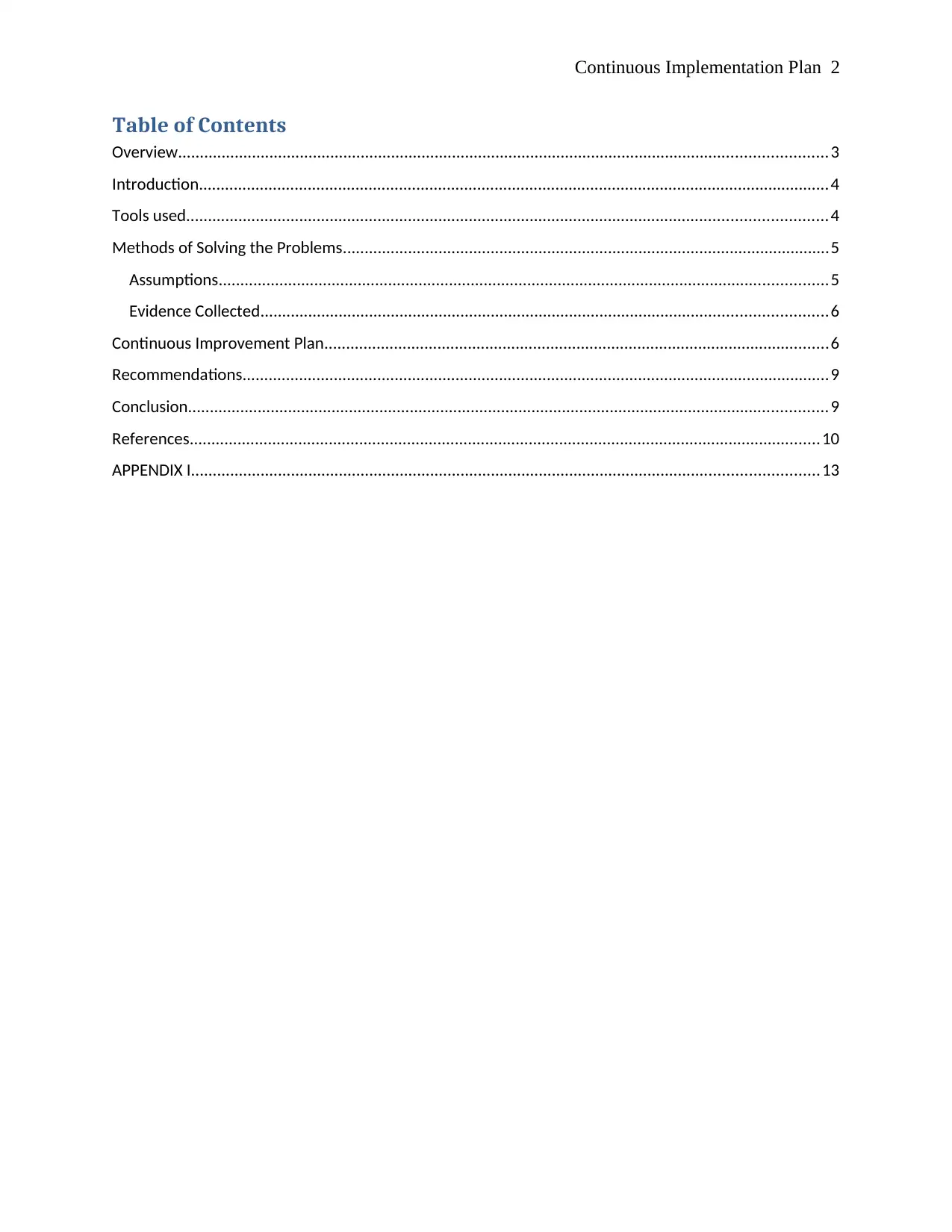
Continuous Implementation Plan 2
Table of Contents
Overview.....................................................................................................................................................3
Introduction.................................................................................................................................................4
Tools used...................................................................................................................................................4
Methods of Solving the Problems................................................................................................................5
Assumptions............................................................................................................................................5
Evidence Collected..................................................................................................................................6
Continuous Improvement Plan....................................................................................................................6
Recommendations.......................................................................................................................................9
Conclusion...................................................................................................................................................9
References.................................................................................................................................................10
APPENDIX I................................................................................................................................................13
Table of Contents
Overview.....................................................................................................................................................3
Introduction.................................................................................................................................................4
Tools used...................................................................................................................................................4
Methods of Solving the Problems................................................................................................................5
Assumptions............................................................................................................................................5
Evidence Collected..................................................................................................................................6
Continuous Improvement Plan....................................................................................................................6
Recommendations.......................................................................................................................................9
Conclusion...................................................................................................................................................9
References.................................................................................................................................................10
APPENDIX I................................................................................................................................................13
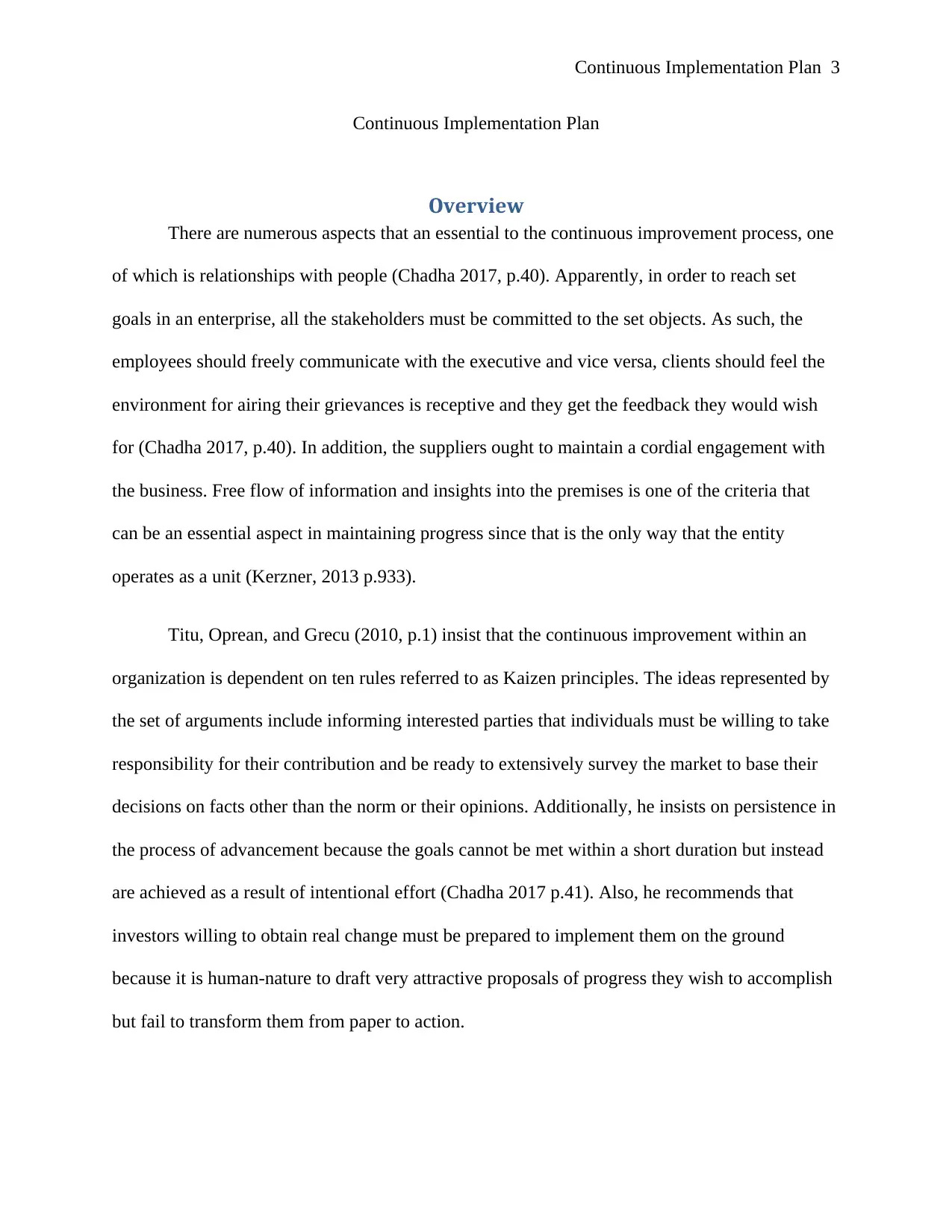
Continuous Implementation Plan 3
Continuous Implementation Plan
Overview
There are numerous aspects that an essential to the continuous improvement process, one
of which is relationships with people (Chadha 2017, p.40). Apparently, in order to reach set
goals in an enterprise, all the stakeholders must be committed to the set objects. As such, the
employees should freely communicate with the executive and vice versa, clients should feel the
environment for airing their grievances is receptive and they get the feedback they would wish
for (Chadha 2017, p.40). In addition, the suppliers ought to maintain a cordial engagement with
the business. Free flow of information and insights into the premises is one of the criteria that
can be an essential aspect in maintaining progress since that is the only way that the entity
operates as a unit (Kerzner, 2013 p.933).
Titu, Oprean, and Grecu (2010, p.1) insist that the continuous improvement within an
organization is dependent on ten rules referred to as Kaizen principles. The ideas represented by
the set of arguments include informing interested parties that individuals must be willing to take
responsibility for their contribution and be ready to extensively survey the market to base their
decisions on facts other than the norm or their opinions. Additionally, he insists on persistence in
the process of advancement because the goals cannot be met within a short duration but instead
are achieved as a result of intentional effort (Chadha 2017 p.41). Also, he recommends that
investors willing to obtain real change must be prepared to implement them on the ground
because it is human-nature to draft very attractive proposals of progress they wish to accomplish
but fail to transform them from paper to action.
Continuous Implementation Plan
Overview
There are numerous aspects that an essential to the continuous improvement process, one
of which is relationships with people (Chadha 2017, p.40). Apparently, in order to reach set
goals in an enterprise, all the stakeholders must be committed to the set objects. As such, the
employees should freely communicate with the executive and vice versa, clients should feel the
environment for airing their grievances is receptive and they get the feedback they would wish
for (Chadha 2017, p.40). In addition, the suppliers ought to maintain a cordial engagement with
the business. Free flow of information and insights into the premises is one of the criteria that
can be an essential aspect in maintaining progress since that is the only way that the entity
operates as a unit (Kerzner, 2013 p.933).
Titu, Oprean, and Grecu (2010, p.1) insist that the continuous improvement within an
organization is dependent on ten rules referred to as Kaizen principles. The ideas represented by
the set of arguments include informing interested parties that individuals must be willing to take
responsibility for their contribution and be ready to extensively survey the market to base their
decisions on facts other than the norm or their opinions. Additionally, he insists on persistence in
the process of advancement because the goals cannot be met within a short duration but instead
are achieved as a result of intentional effort (Chadha 2017 p.41). Also, he recommends that
investors willing to obtain real change must be prepared to implement them on the ground
because it is human-nature to draft very attractive proposals of progress they wish to accomplish
but fail to transform them from paper to action.
⊘ This is a preview!⊘
Do you want full access?
Subscribe today to unlock all pages.

Trusted by 1+ million students worldwide
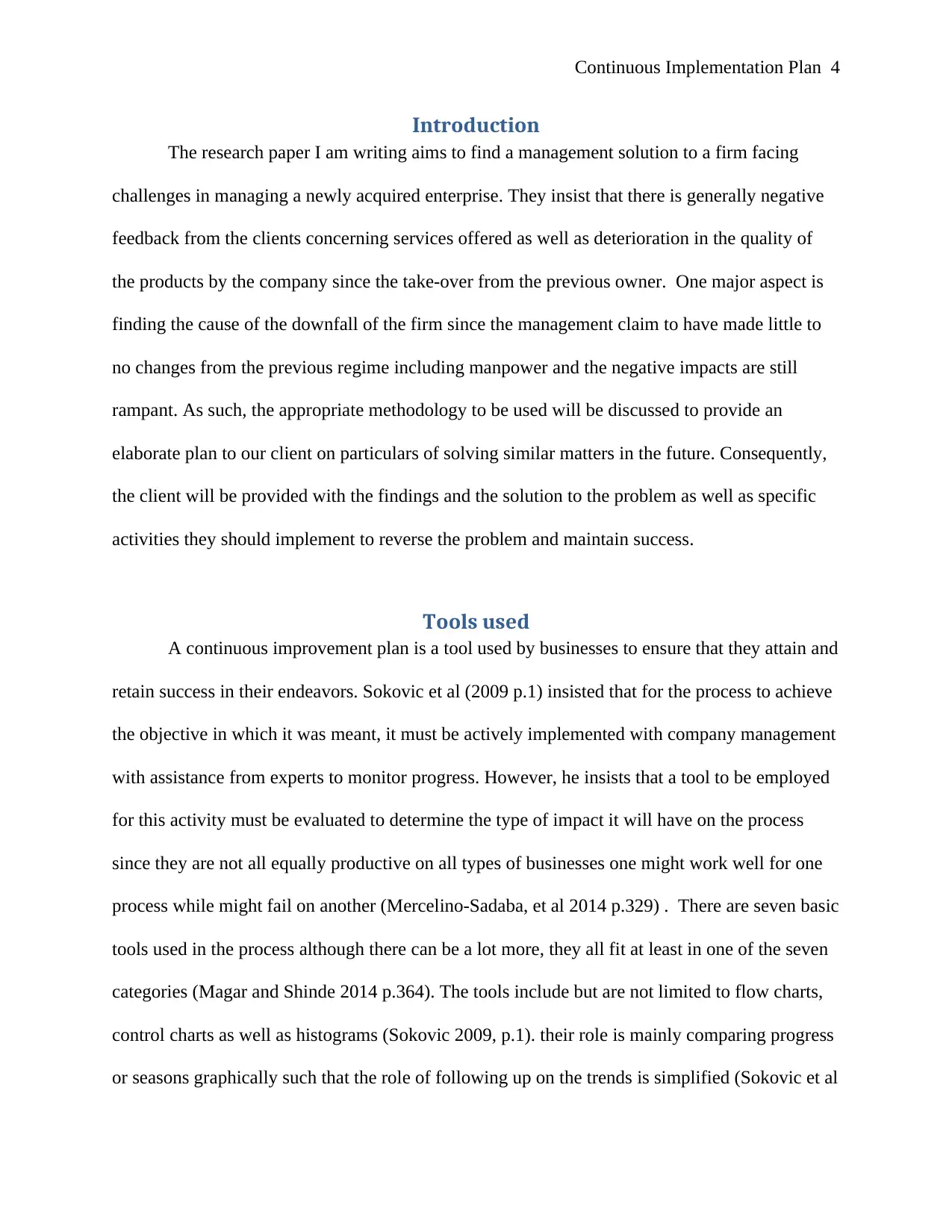
Continuous Implementation Plan 4
Introduction
The research paper I am writing aims to find a management solution to a firm facing
challenges in managing a newly acquired enterprise. They insist that there is generally negative
feedback from the clients concerning services offered as well as deterioration in the quality of
the products by the company since the take-over from the previous owner. One major aspect is
finding the cause of the downfall of the firm since the management claim to have made little to
no changes from the previous regime including manpower and the negative impacts are still
rampant. As such, the appropriate methodology to be used will be discussed to provide an
elaborate plan to our client on particulars of solving similar matters in the future. Consequently,
the client will be provided with the findings and the solution to the problem as well as specific
activities they should implement to reverse the problem and maintain success.
Tools used
A continuous improvement plan is a tool used by businesses to ensure that they attain and
retain success in their endeavors. Sokovic et al (2009 p.1) insisted that for the process to achieve
the objective in which it was meant, it must be actively implemented with company management
with assistance from experts to monitor progress. However, he insists that a tool to be employed
for this activity must be evaluated to determine the type of impact it will have on the process
since they are not all equally productive on all types of businesses one might work well for one
process while might fail on another (Mercelino-Sadaba, et al 2014 p.329) . There are seven basic
tools used in the process although there can be a lot more, they all fit at least in one of the seven
categories (Magar and Shinde 2014 p.364). The tools include but are not limited to flow charts,
control charts as well as histograms (Sokovic 2009, p.1). their role is mainly comparing progress
or seasons graphically such that the role of following up on the trends is simplified (Sokovic et al
Introduction
The research paper I am writing aims to find a management solution to a firm facing
challenges in managing a newly acquired enterprise. They insist that there is generally negative
feedback from the clients concerning services offered as well as deterioration in the quality of
the products by the company since the take-over from the previous owner. One major aspect is
finding the cause of the downfall of the firm since the management claim to have made little to
no changes from the previous regime including manpower and the negative impacts are still
rampant. As such, the appropriate methodology to be used will be discussed to provide an
elaborate plan to our client on particulars of solving similar matters in the future. Consequently,
the client will be provided with the findings and the solution to the problem as well as specific
activities they should implement to reverse the problem and maintain success.
Tools used
A continuous improvement plan is a tool used by businesses to ensure that they attain and
retain success in their endeavors. Sokovic et al (2009 p.1) insisted that for the process to achieve
the objective in which it was meant, it must be actively implemented with company management
with assistance from experts to monitor progress. However, he insists that a tool to be employed
for this activity must be evaluated to determine the type of impact it will have on the process
since they are not all equally productive on all types of businesses one might work well for one
process while might fail on another (Mercelino-Sadaba, et al 2014 p.329) . There are seven basic
tools used in the process although there can be a lot more, they all fit at least in one of the seven
categories (Magar and Shinde 2014 p.364). The tools include but are not limited to flow charts,
control charts as well as histograms (Sokovic 2009, p.1). their role is mainly comparing progress
or seasons graphically such that the role of following up on the trends is simplified (Sokovic et al
Paraphrase This Document
Need a fresh take? Get an instant paraphrase of this document with our AI Paraphraser
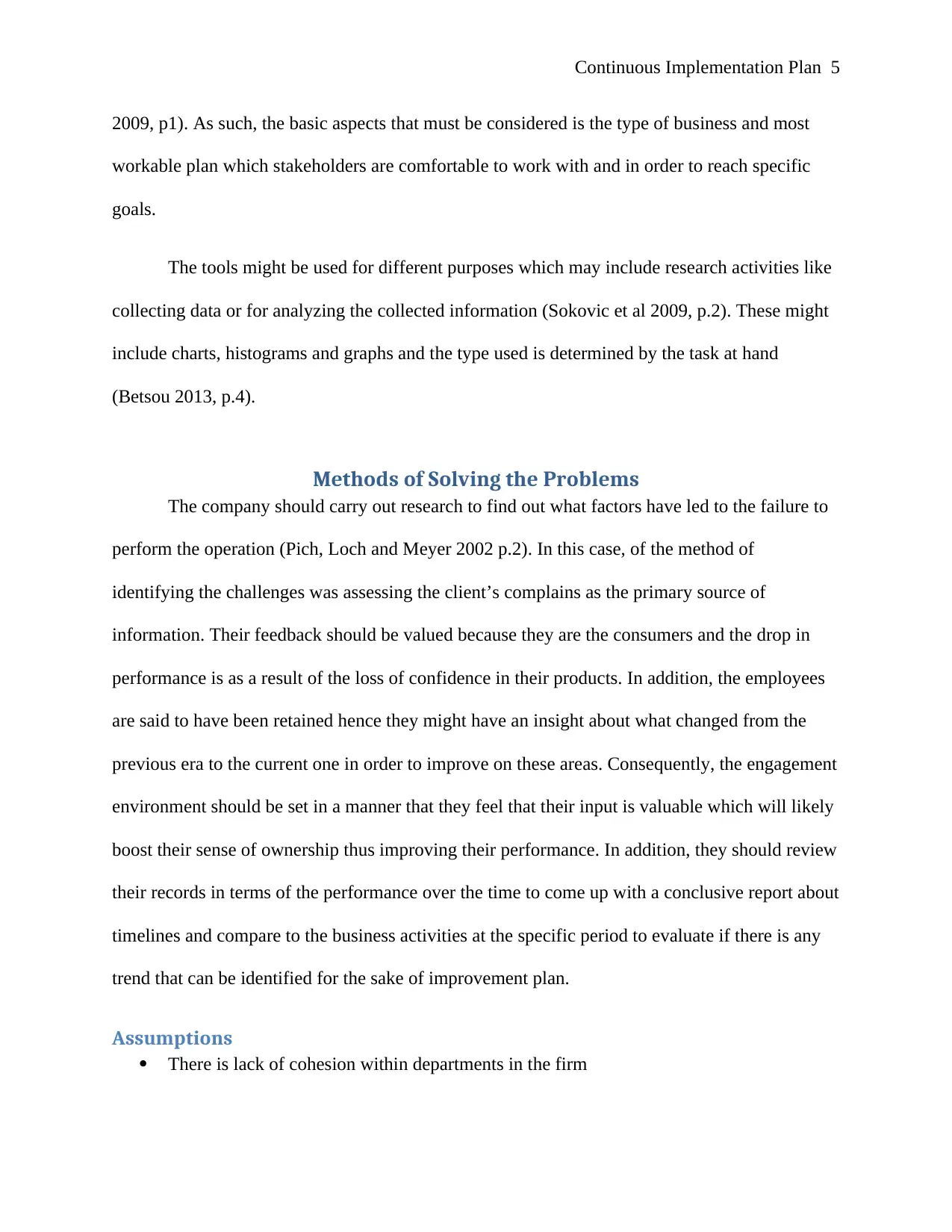
Continuous Implementation Plan 5
2009, p1). As such, the basic aspects that must be considered is the type of business and most
workable plan which stakeholders are comfortable to work with and in order to reach specific
goals.
The tools might be used for different purposes which may include research activities like
collecting data or for analyzing the collected information (Sokovic et al 2009, p.2). These might
include charts, histograms and graphs and the type used is determined by the task at hand
(Betsou 2013, p.4).
Methods of Solving the Problems
The company should carry out research to find out what factors have led to the failure to
perform the operation (Pich, Loch and Meyer 2002 p.2). In this case, of the method of
identifying the challenges was assessing the client’s complains as the primary source of
information. Their feedback should be valued because they are the consumers and the drop in
performance is as a result of the loss of confidence in their products. In addition, the employees
are said to have been retained hence they might have an insight about what changed from the
previous era to the current one in order to improve on these areas. Consequently, the engagement
environment should be set in a manner that they feel that their input is valuable which will likely
boost their sense of ownership thus improving their performance. In addition, they should review
their records in terms of the performance over the time to come up with a conclusive report about
timelines and compare to the business activities at the specific period to evaluate if there is any
trend that can be identified for the sake of improvement plan.
Assumptions
There is lack of cohesion within departments in the firm
2009, p1). As such, the basic aspects that must be considered is the type of business and most
workable plan which stakeholders are comfortable to work with and in order to reach specific
goals.
The tools might be used for different purposes which may include research activities like
collecting data or for analyzing the collected information (Sokovic et al 2009, p.2). These might
include charts, histograms and graphs and the type used is determined by the task at hand
(Betsou 2013, p.4).
Methods of Solving the Problems
The company should carry out research to find out what factors have led to the failure to
perform the operation (Pich, Loch and Meyer 2002 p.2). In this case, of the method of
identifying the challenges was assessing the client’s complains as the primary source of
information. Their feedback should be valued because they are the consumers and the drop in
performance is as a result of the loss of confidence in their products. In addition, the employees
are said to have been retained hence they might have an insight about what changed from the
previous era to the current one in order to improve on these areas. Consequently, the engagement
environment should be set in a manner that they feel that their input is valuable which will likely
boost their sense of ownership thus improving their performance. In addition, they should review
their records in terms of the performance over the time to come up with a conclusive report about
timelines and compare to the business activities at the specific period to evaluate if there is any
trend that can be identified for the sake of improvement plan.
Assumptions
There is lack of cohesion within departments in the firm
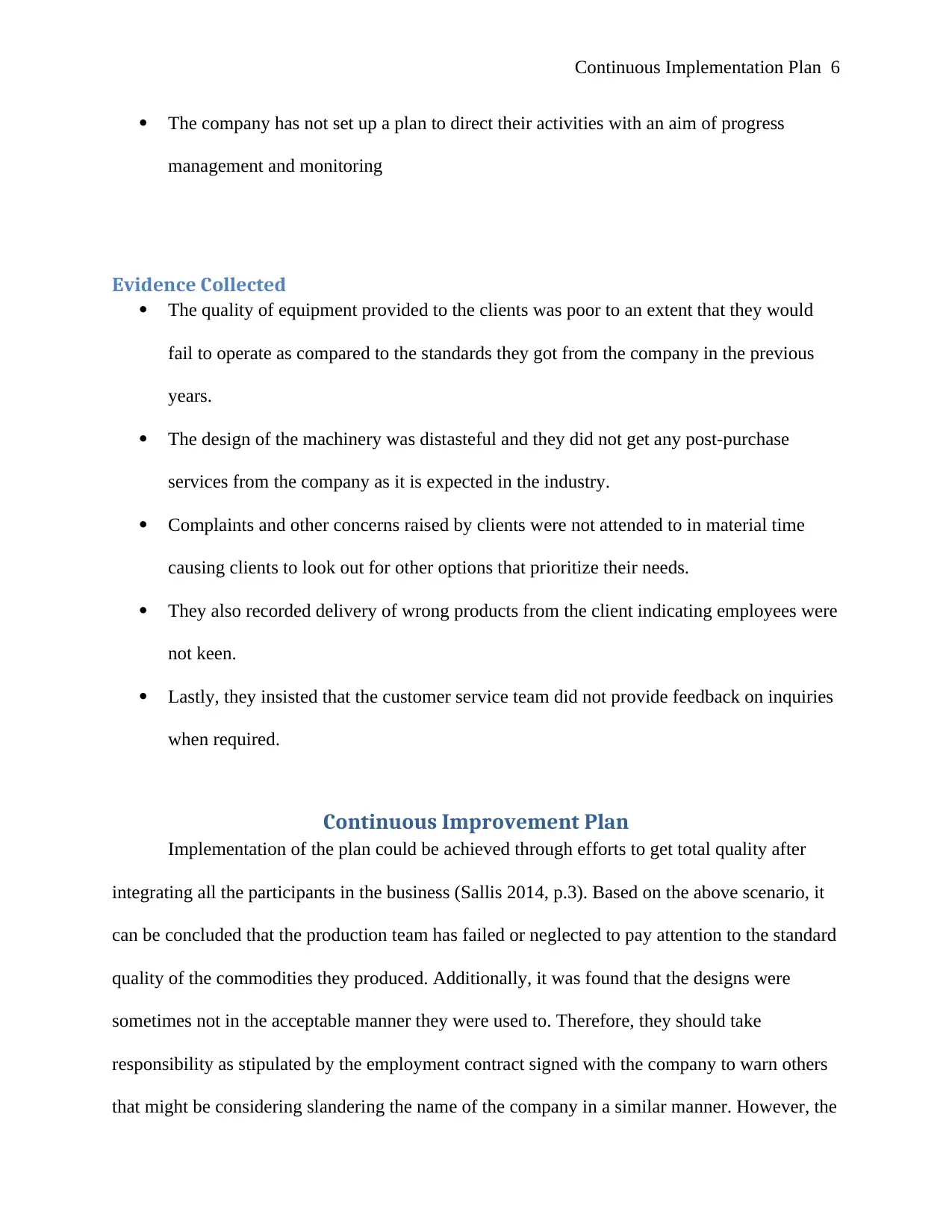
Continuous Implementation Plan 6
The company has not set up a plan to direct their activities with an aim of progress
management and monitoring
Evidence Collected
The quality of equipment provided to the clients was poor to an extent that they would
fail to operate as compared to the standards they got from the company in the previous
years.
The design of the machinery was distasteful and they did not get any post-purchase
services from the company as it is expected in the industry.
Complaints and other concerns raised by clients were not attended to in material time
causing clients to look out for other options that prioritize their needs.
They also recorded delivery of wrong products from the client indicating employees were
not keen.
Lastly, they insisted that the customer service team did not provide feedback on inquiries
when required.
Continuous Improvement Plan
Implementation of the plan could be achieved through efforts to get total quality after
integrating all the participants in the business (Sallis 2014, p.3). Based on the above scenario, it
can be concluded that the production team has failed or neglected to pay attention to the standard
quality of the commodities they produced. Additionally, it was found that the designs were
sometimes not in the acceptable manner they were used to. Therefore, they should take
responsibility as stipulated by the employment contract signed with the company to warn others
that might be considering slandering the name of the company in a similar manner. However, the
The company has not set up a plan to direct their activities with an aim of progress
management and monitoring
Evidence Collected
The quality of equipment provided to the clients was poor to an extent that they would
fail to operate as compared to the standards they got from the company in the previous
years.
The design of the machinery was distasteful and they did not get any post-purchase
services from the company as it is expected in the industry.
Complaints and other concerns raised by clients were not attended to in material time
causing clients to look out for other options that prioritize their needs.
They also recorded delivery of wrong products from the client indicating employees were
not keen.
Lastly, they insisted that the customer service team did not provide feedback on inquiries
when required.
Continuous Improvement Plan
Implementation of the plan could be achieved through efforts to get total quality after
integrating all the participants in the business (Sallis 2014, p.3). Based on the above scenario, it
can be concluded that the production team has failed or neglected to pay attention to the standard
quality of the commodities they produced. Additionally, it was found that the designs were
sometimes not in the acceptable manner they were used to. Therefore, they should take
responsibility as stipulated by the employment contract signed with the company to warn others
that might be considering slandering the name of the company in a similar manner. However, the
⊘ This is a preview!⊘
Do you want full access?
Subscribe today to unlock all pages.

Trusted by 1+ million students worldwide
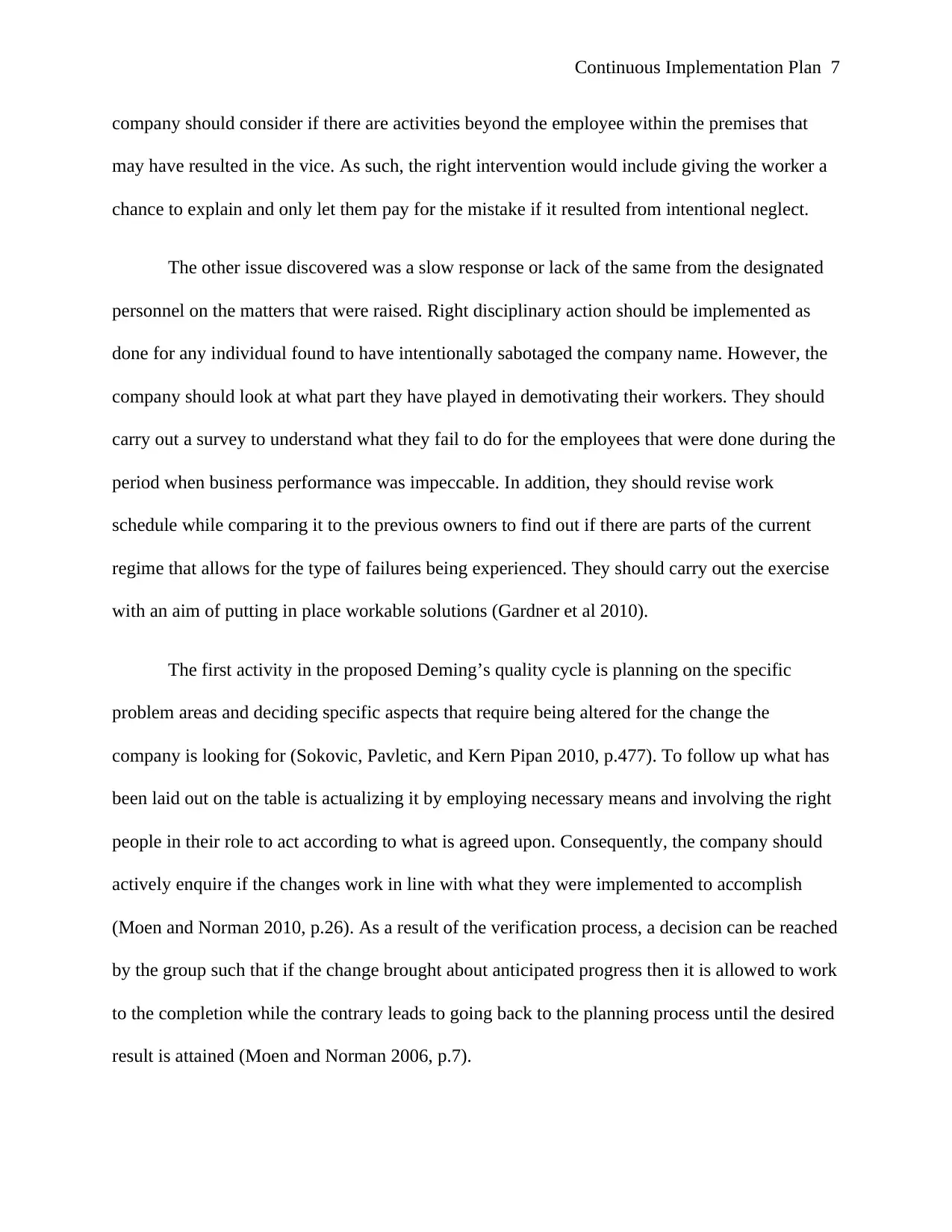
Continuous Implementation Plan 7
company should consider if there are activities beyond the employee within the premises that
may have resulted in the vice. As such, the right intervention would include giving the worker a
chance to explain and only let them pay for the mistake if it resulted from intentional neglect.
The other issue discovered was a slow response or lack of the same from the designated
personnel on the matters that were raised. Right disciplinary action should be implemented as
done for any individual found to have intentionally sabotaged the company name. However, the
company should look at what part they have played in demotivating their workers. They should
carry out a survey to understand what they fail to do for the employees that were done during the
period when business performance was impeccable. In addition, they should revise work
schedule while comparing it to the previous owners to find out if there are parts of the current
regime that allows for the type of failures being experienced. They should carry out the exercise
with an aim of putting in place workable solutions (Gardner et al 2010).
The first activity in the proposed Deming’s quality cycle is planning on the specific
problem areas and deciding specific aspects that require being altered for the change the
company is looking for (Sokovic, Pavletic, and Kern Pipan 2010, p.477). To follow up what has
been laid out on the table is actualizing it by employing necessary means and involving the right
people in their role to act according to what is agreed upon. Consequently, the company should
actively enquire if the changes work in line with what they were implemented to accomplish
(Moen and Norman 2010, p.26). As a result of the verification process, a decision can be reached
by the group such that if the change brought about anticipated progress then it is allowed to work
to the completion while the contrary leads to going back to the planning process until the desired
result is attained (Moen and Norman 2006, p.7).
company should consider if there are activities beyond the employee within the premises that
may have resulted in the vice. As such, the right intervention would include giving the worker a
chance to explain and only let them pay for the mistake if it resulted from intentional neglect.
The other issue discovered was a slow response or lack of the same from the designated
personnel on the matters that were raised. Right disciplinary action should be implemented as
done for any individual found to have intentionally sabotaged the company name. However, the
company should look at what part they have played in demotivating their workers. They should
carry out a survey to understand what they fail to do for the employees that were done during the
period when business performance was impeccable. In addition, they should revise work
schedule while comparing it to the previous owners to find out if there are parts of the current
regime that allows for the type of failures being experienced. They should carry out the exercise
with an aim of putting in place workable solutions (Gardner et al 2010).
The first activity in the proposed Deming’s quality cycle is planning on the specific
problem areas and deciding specific aspects that require being altered for the change the
company is looking for (Sokovic, Pavletic, and Kern Pipan 2010, p.477). To follow up what has
been laid out on the table is actualizing it by employing necessary means and involving the right
people in their role to act according to what is agreed upon. Consequently, the company should
actively enquire if the changes work in line with what they were implemented to accomplish
(Moen and Norman 2010, p.26). As a result of the verification process, a decision can be reached
by the group such that if the change brought about anticipated progress then it is allowed to work
to the completion while the contrary leads to going back to the planning process until the desired
result is attained (Moen and Norman 2006, p.7).
Paraphrase This Document
Need a fresh take? Get an instant paraphrase of this document with our AI Paraphraser
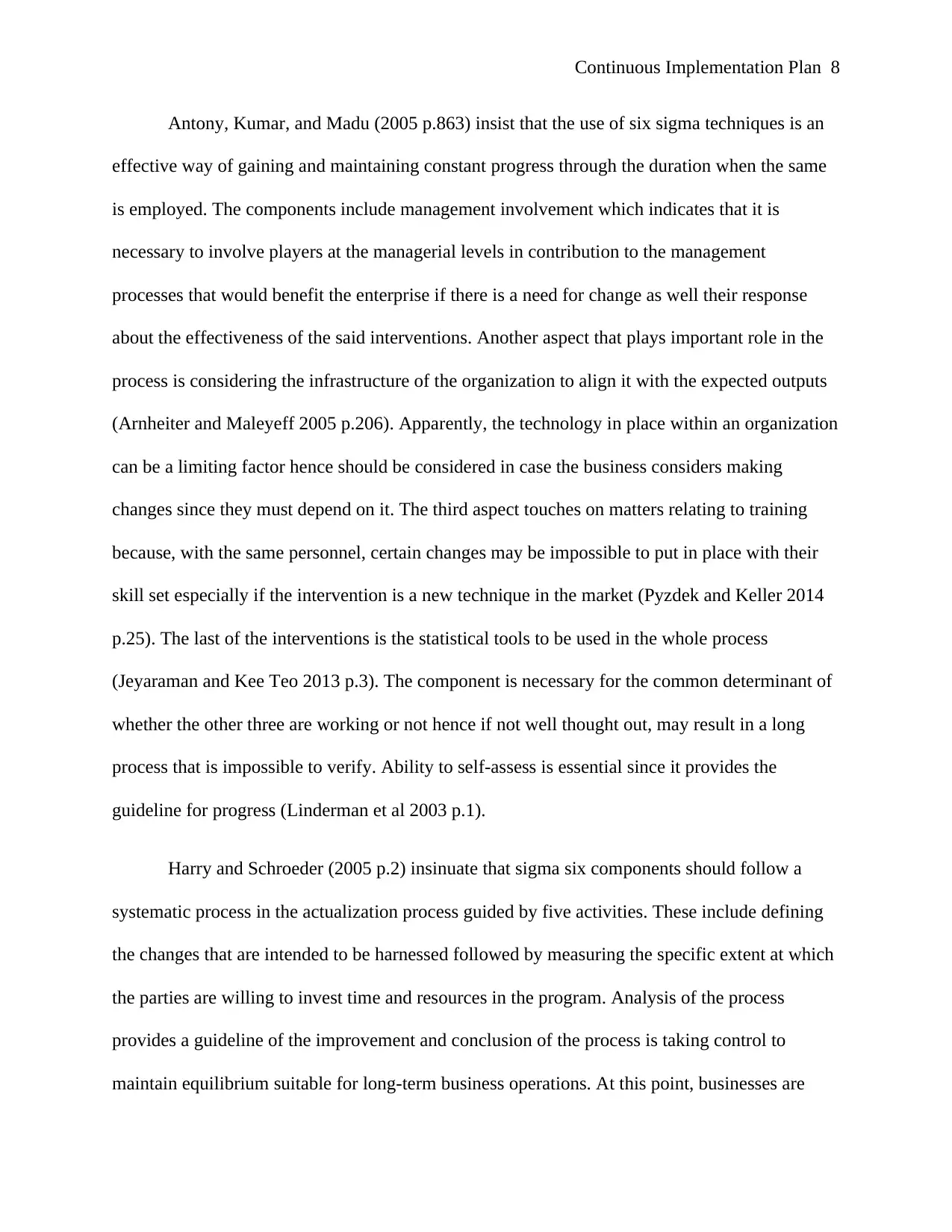
Continuous Implementation Plan 8
Antony, Kumar, and Madu (2005 p.863) insist that the use of six sigma techniques is an
effective way of gaining and maintaining constant progress through the duration when the same
is employed. The components include management involvement which indicates that it is
necessary to involve players at the managerial levels in contribution to the management
processes that would benefit the enterprise if there is a need for change as well their response
about the effectiveness of the said interventions. Another aspect that plays important role in the
process is considering the infrastructure of the organization to align it with the expected outputs
(Arnheiter and Maleyeff 2005 p.206). Apparently, the technology in place within an organization
can be a limiting factor hence should be considered in case the business considers making
changes since they must depend on it. The third aspect touches on matters relating to training
because, with the same personnel, certain changes may be impossible to put in place with their
skill set especially if the intervention is a new technique in the market (Pyzdek and Keller 2014
p.25). The last of the interventions is the statistical tools to be used in the whole process
(Jeyaraman and Kee Teo 2013 p.3). The component is necessary for the common determinant of
whether the other three are working or not hence if not well thought out, may result in a long
process that is impossible to verify. Ability to self-assess is essential since it provides the
guideline for progress (Linderman et al 2003 p.1).
Harry and Schroeder (2005 p.2) insinuate that sigma six components should follow a
systematic process in the actualization process guided by five activities. These include defining
the changes that are intended to be harnessed followed by measuring the specific extent at which
the parties are willing to invest time and resources in the program. Analysis of the process
provides a guideline of the improvement and conclusion of the process is taking control to
maintain equilibrium suitable for long-term business operations. At this point, businesses are
Antony, Kumar, and Madu (2005 p.863) insist that the use of six sigma techniques is an
effective way of gaining and maintaining constant progress through the duration when the same
is employed. The components include management involvement which indicates that it is
necessary to involve players at the managerial levels in contribution to the management
processes that would benefit the enterprise if there is a need for change as well their response
about the effectiveness of the said interventions. Another aspect that plays important role in the
process is considering the infrastructure of the organization to align it with the expected outputs
(Arnheiter and Maleyeff 2005 p.206). Apparently, the technology in place within an organization
can be a limiting factor hence should be considered in case the business considers making
changes since they must depend on it. The third aspect touches on matters relating to training
because, with the same personnel, certain changes may be impossible to put in place with their
skill set especially if the intervention is a new technique in the market (Pyzdek and Keller 2014
p.25). The last of the interventions is the statistical tools to be used in the whole process
(Jeyaraman and Kee Teo 2013 p.3). The component is necessary for the common determinant of
whether the other three are working or not hence if not well thought out, may result in a long
process that is impossible to verify. Ability to self-assess is essential since it provides the
guideline for progress (Linderman et al 2003 p.1).
Harry and Schroeder (2005 p.2) insinuate that sigma six components should follow a
systematic process in the actualization process guided by five activities. These include defining
the changes that are intended to be harnessed followed by measuring the specific extent at which
the parties are willing to invest time and resources in the program. Analysis of the process
provides a guideline of the improvement and conclusion of the process is taking control to
maintain equilibrium suitable for long-term business operations. At this point, businesses are
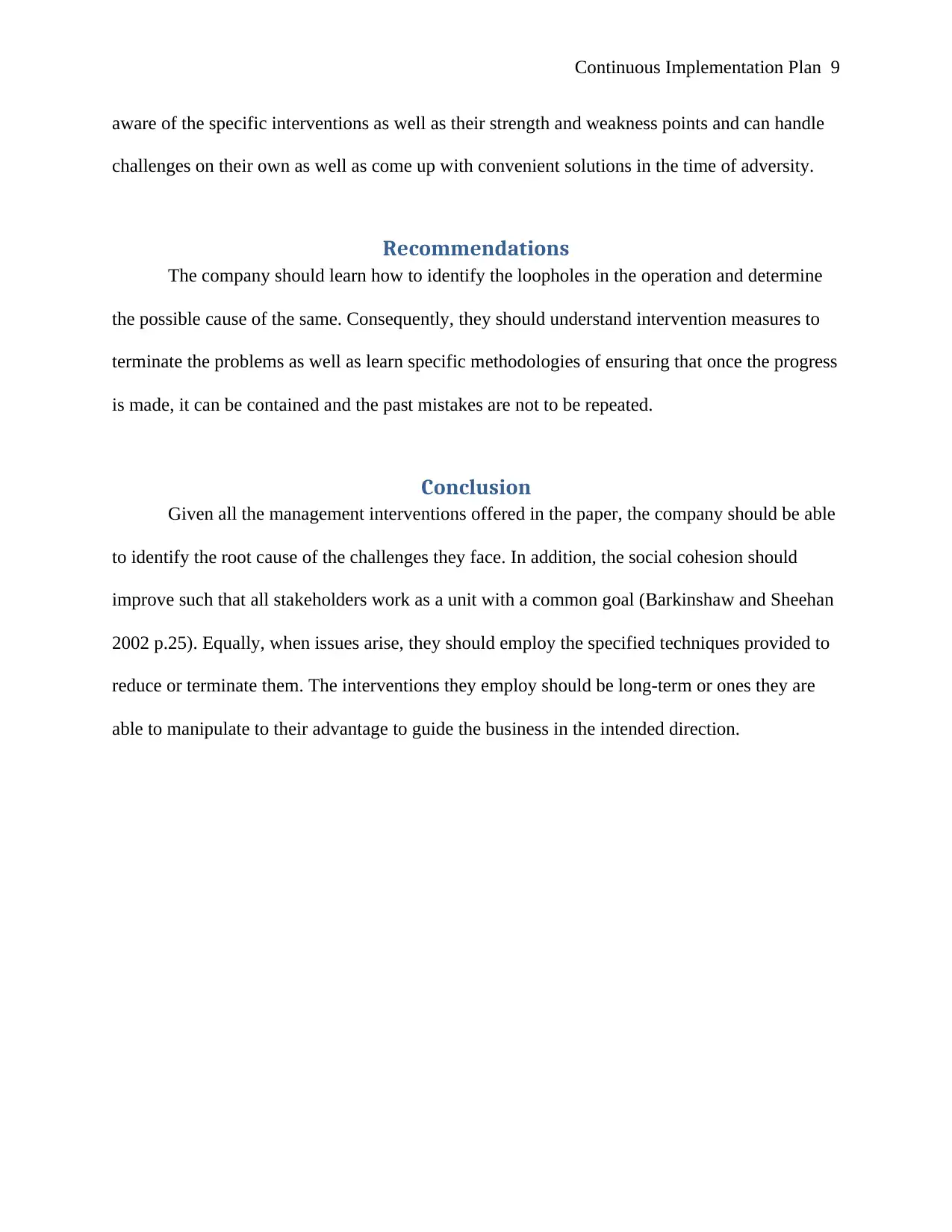
Continuous Implementation Plan 9
aware of the specific interventions as well as their strength and weakness points and can handle
challenges on their own as well as come up with convenient solutions in the time of adversity.
Recommendations
The company should learn how to identify the loopholes in the operation and determine
the possible cause of the same. Consequently, they should understand intervention measures to
terminate the problems as well as learn specific methodologies of ensuring that once the progress
is made, it can be contained and the past mistakes are not to be repeated.
Conclusion
Given all the management interventions offered in the paper, the company should be able
to identify the root cause of the challenges they face. In addition, the social cohesion should
improve such that all stakeholders work as a unit with a common goal (Barkinshaw and Sheehan
2002 p.25). Equally, when issues arise, they should employ the specified techniques provided to
reduce or terminate them. The interventions they employ should be long-term or ones they are
able to manipulate to their advantage to guide the business in the intended direction.
aware of the specific interventions as well as their strength and weakness points and can handle
challenges on their own as well as come up with convenient solutions in the time of adversity.
Recommendations
The company should learn how to identify the loopholes in the operation and determine
the possible cause of the same. Consequently, they should understand intervention measures to
terminate the problems as well as learn specific methodologies of ensuring that once the progress
is made, it can be contained and the past mistakes are not to be repeated.
Conclusion
Given all the management interventions offered in the paper, the company should be able
to identify the root cause of the challenges they face. In addition, the social cohesion should
improve such that all stakeholders work as a unit with a common goal (Barkinshaw and Sheehan
2002 p.25). Equally, when issues arise, they should employ the specified techniques provided to
reduce or terminate them. The interventions they employ should be long-term or ones they are
able to manipulate to their advantage to guide the business in the intended direction.
⊘ This is a preview!⊘
Do you want full access?
Subscribe today to unlock all pages.

Trusted by 1+ million students worldwide
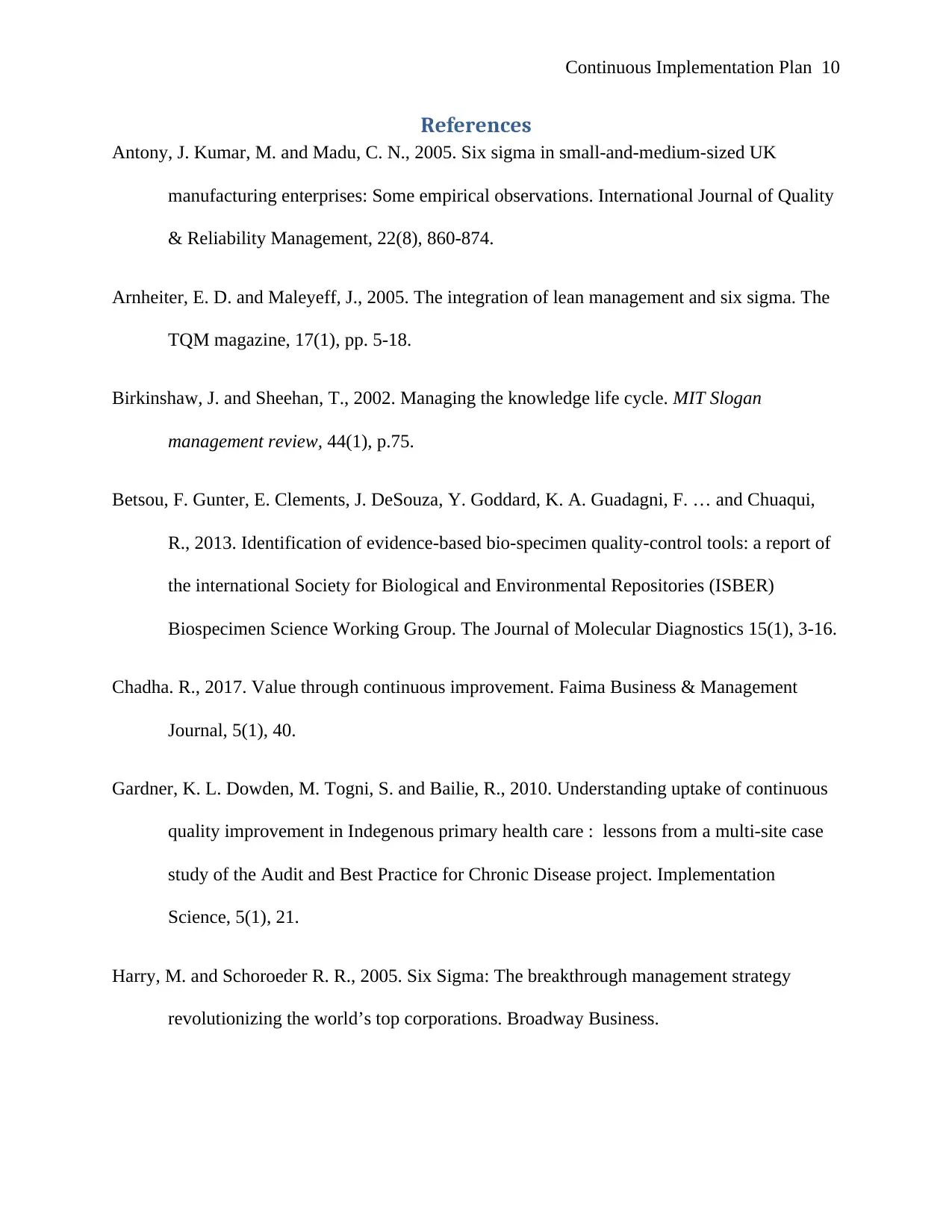
Continuous Implementation Plan 10
References
Antony, J. Kumar, M. and Madu, C. N., 2005. Six sigma in small-and-medium-sized UK
manufacturing enterprises: Some empirical observations. International Journal of Quality
& Reliability Management, 22(8), 860-874.
Arnheiter, E. D. and Maleyeff, J., 2005. The integration of lean management and six sigma. The
TQM magazine, 17(1), pp. 5-18.
Birkinshaw, J. and Sheehan, T., 2002. Managing the knowledge life cycle. MIT Slogan
management review, 44(1), p.75.
Betsou, F. Gunter, E. Clements, J. DeSouza, Y. Goddard, K. A. Guadagni, F. … and Chuaqui,
R., 2013. Identification of evidence-based bio-specimen quality-control tools: a report of
the international Society for Biological and Environmental Repositories (ISBER)
Biospecimen Science Working Group. The Journal of Molecular Diagnostics 15(1), 3-16.
Chadha. R., 2017. Value through continuous improvement. Faima Business & Management
Journal, 5(1), 40.
Gardner, K. L. Dowden, M. Togni, S. and Bailie, R., 2010. Understanding uptake of continuous
quality improvement in Indegenous primary health care : lessons from a multi-site case
study of the Audit and Best Practice for Chronic Disease project. Implementation
Science, 5(1), 21.
Harry, M. and Schoroeder R. R., 2005. Six Sigma: The breakthrough management strategy
revolutionizing the world’s top corporations. Broadway Business.
References
Antony, J. Kumar, M. and Madu, C. N., 2005. Six sigma in small-and-medium-sized UK
manufacturing enterprises: Some empirical observations. International Journal of Quality
& Reliability Management, 22(8), 860-874.
Arnheiter, E. D. and Maleyeff, J., 2005. The integration of lean management and six sigma. The
TQM magazine, 17(1), pp. 5-18.
Birkinshaw, J. and Sheehan, T., 2002. Managing the knowledge life cycle. MIT Slogan
management review, 44(1), p.75.
Betsou, F. Gunter, E. Clements, J. DeSouza, Y. Goddard, K. A. Guadagni, F. … and Chuaqui,
R., 2013. Identification of evidence-based bio-specimen quality-control tools: a report of
the international Society for Biological and Environmental Repositories (ISBER)
Biospecimen Science Working Group. The Journal of Molecular Diagnostics 15(1), 3-16.
Chadha. R., 2017. Value through continuous improvement. Faima Business & Management
Journal, 5(1), 40.
Gardner, K. L. Dowden, M. Togni, S. and Bailie, R., 2010. Understanding uptake of continuous
quality improvement in Indegenous primary health care : lessons from a multi-site case
study of the Audit and Best Practice for Chronic Disease project. Implementation
Science, 5(1), 21.
Harry, M. and Schoroeder R. R., 2005. Six Sigma: The breakthrough management strategy
revolutionizing the world’s top corporations. Broadway Business.
Paraphrase This Document
Need a fresh take? Get an instant paraphrase of this document with our AI Paraphraser
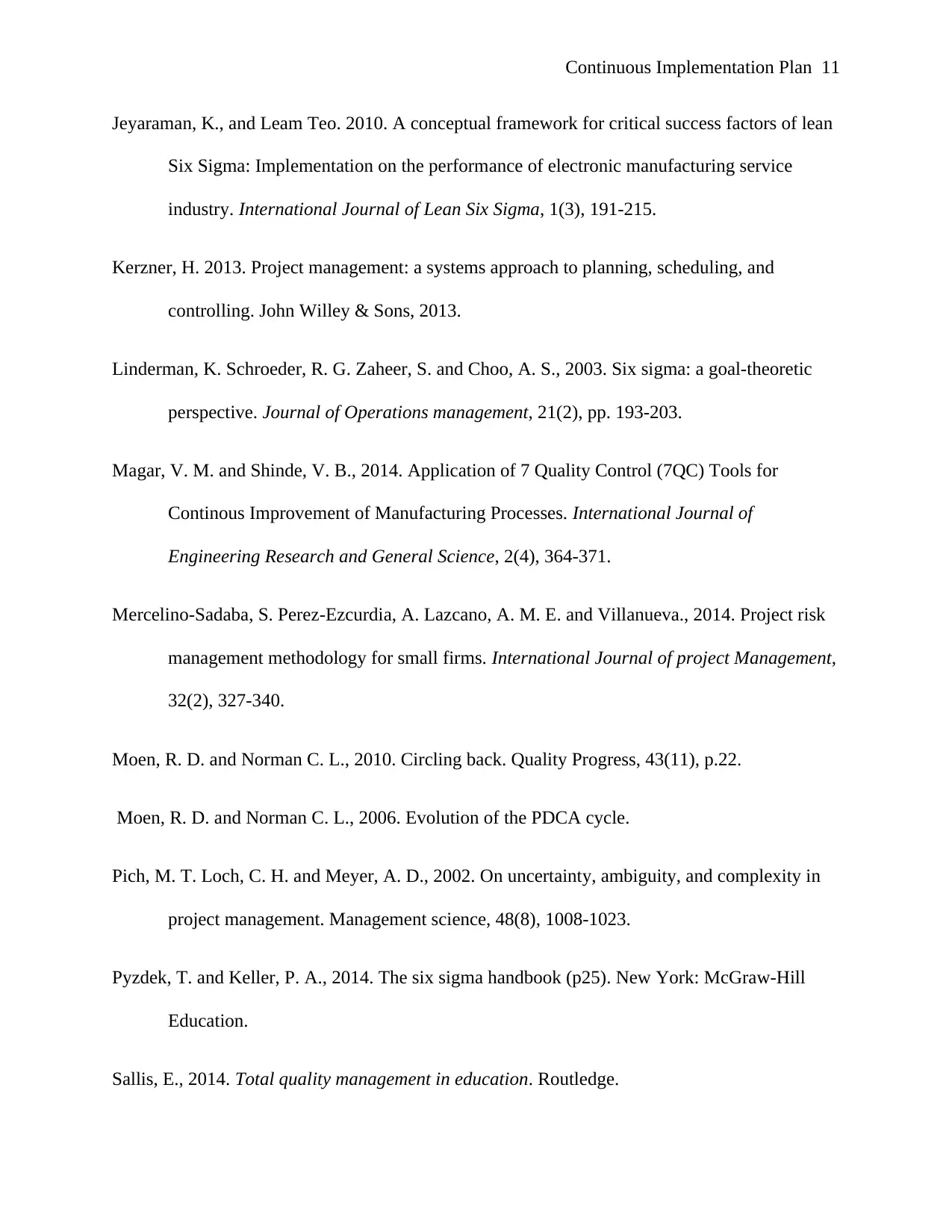
Continuous Implementation Plan 11
Jeyaraman, K., and Leam Teo. 2010. A conceptual framework for critical success factors of lean
Six Sigma: Implementation on the performance of electronic manufacturing service
industry. International Journal of Lean Six Sigma, 1(3), 191-215.
Kerzner, H. 2013. Project management: a systems approach to planning, scheduling, and
controlling. John Willey & Sons, 2013.
Linderman, K. Schroeder, R. G. Zaheer, S. and Choo, A. S., 2003. Six sigma: a goal-theoretic
perspective. Journal of Operations management, 21(2), pp. 193-203.
Magar, V. M. and Shinde, V. B., 2014. Application of 7 Quality Control (7QC) Tools for
Continous Improvement of Manufacturing Processes. International Journal of
Engineering Research and General Science, 2(4), 364-371.
Mercelino-Sadaba, S. Perez-Ezcurdia, A. Lazcano, A. M. E. and Villanueva., 2014. Project risk
management methodology for small firms. International Journal of project Management,
32(2), 327-340.
Moen, R. D. and Norman C. L., 2010. Circling back. Quality Progress, 43(11), p.22.
Moen, R. D. and Norman C. L., 2006. Evolution of the PDCA cycle.
Pich, M. T. Loch, C. H. and Meyer, A. D., 2002. On uncertainty, ambiguity, and complexity in
project management. Management science, 48(8), 1008-1023.
Pyzdek, T. and Keller, P. A., 2014. The six sigma handbook (p25). New York: McGraw-Hill
Education.
Sallis, E., 2014. Total quality management in education. Routledge.
Jeyaraman, K., and Leam Teo. 2010. A conceptual framework for critical success factors of lean
Six Sigma: Implementation on the performance of electronic manufacturing service
industry. International Journal of Lean Six Sigma, 1(3), 191-215.
Kerzner, H. 2013. Project management: a systems approach to planning, scheduling, and
controlling. John Willey & Sons, 2013.
Linderman, K. Schroeder, R. G. Zaheer, S. and Choo, A. S., 2003. Six sigma: a goal-theoretic
perspective. Journal of Operations management, 21(2), pp. 193-203.
Magar, V. M. and Shinde, V. B., 2014. Application of 7 Quality Control (7QC) Tools for
Continous Improvement of Manufacturing Processes. International Journal of
Engineering Research and General Science, 2(4), 364-371.
Mercelino-Sadaba, S. Perez-Ezcurdia, A. Lazcano, A. M. E. and Villanueva., 2014. Project risk
management methodology for small firms. International Journal of project Management,
32(2), 327-340.
Moen, R. D. and Norman C. L., 2010. Circling back. Quality Progress, 43(11), p.22.
Moen, R. D. and Norman C. L., 2006. Evolution of the PDCA cycle.
Pich, M. T. Loch, C. H. and Meyer, A. D., 2002. On uncertainty, ambiguity, and complexity in
project management. Management science, 48(8), 1008-1023.
Pyzdek, T. and Keller, P. A., 2014. The six sigma handbook (p25). New York: McGraw-Hill
Education.
Sallis, E., 2014. Total quality management in education. Routledge.
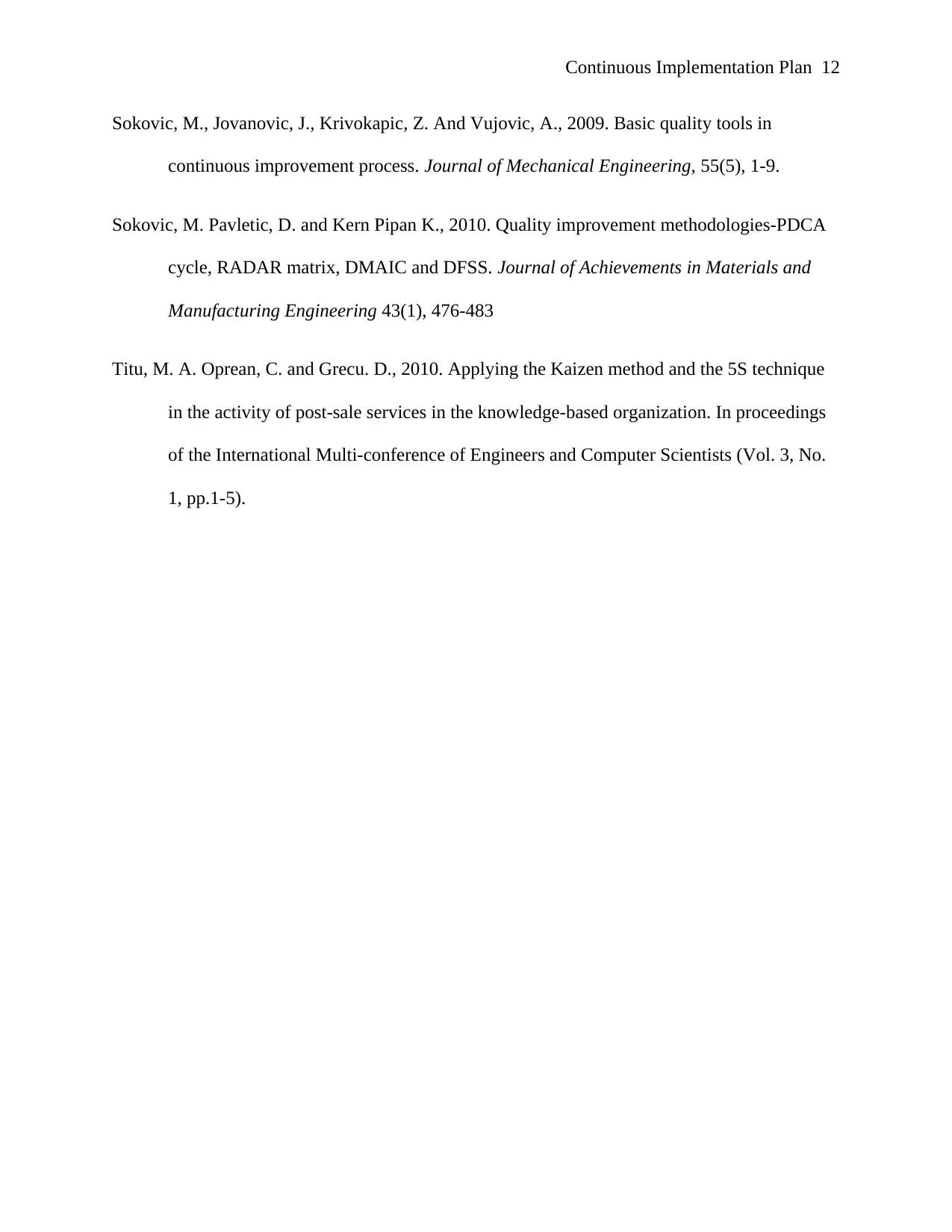
Continuous Implementation Plan 12
Sokovic, M., Jovanovic, J., Krivokapic, Z. And Vujovic, A., 2009. Basic quality tools in
continuous improvement process. Journal of Mechanical Engineering, 55(5), 1-9.
Sokovic, M. Pavletic, D. and Kern Pipan K., 2010. Quality improvement methodologies-PDCA
cycle, RADAR matrix, DMAIC and DFSS. Journal of Achievements in Materials and
Manufacturing Engineering 43(1), 476-483
Titu, M. A. Oprean, C. and Grecu. D., 2010. Applying the Kaizen method and the 5S technique
in the activity of post-sale services in the knowledge-based organization. In proceedings
of the International Multi-conference of Engineers and Computer Scientists (Vol. 3, No.
1, pp.1-5).
Sokovic, M., Jovanovic, J., Krivokapic, Z. And Vujovic, A., 2009. Basic quality tools in
continuous improvement process. Journal of Mechanical Engineering, 55(5), 1-9.
Sokovic, M. Pavletic, D. and Kern Pipan K., 2010. Quality improvement methodologies-PDCA
cycle, RADAR matrix, DMAIC and DFSS. Journal of Achievements in Materials and
Manufacturing Engineering 43(1), 476-483
Titu, M. A. Oprean, C. and Grecu. D., 2010. Applying the Kaizen method and the 5S technique
in the activity of post-sale services in the knowledge-based organization. In proceedings
of the International Multi-conference of Engineers and Computer Scientists (Vol. 3, No.
1, pp.1-5).
⊘ This is a preview!⊘
Do you want full access?
Subscribe today to unlock all pages.

Trusted by 1+ million students worldwide
1 out of 13
Related Documents
Your All-in-One AI-Powered Toolkit for Academic Success.
+13062052269
info@desklib.com
Available 24*7 on WhatsApp / Email
![[object Object]](/_next/static/media/star-bottom.7253800d.svg)
Unlock your academic potential
Copyright © 2020–2025 A2Z Services. All Rights Reserved. Developed and managed by ZUCOL.





